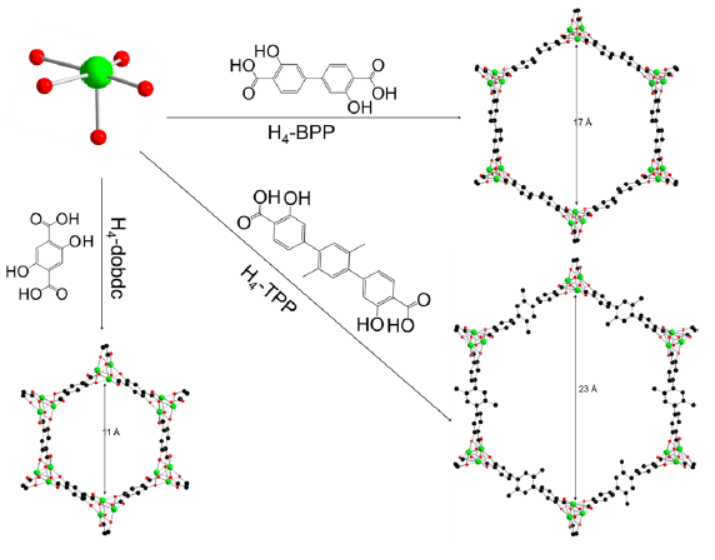Home >
News > Pore-Engineered MOFs for Cooling
Pore-Engineered MOFs for Cooling
Summary:
The authors from Pacific Northwest National Laboratory (PNNL) developed pore-engineered Ni-MOF-74 series materials (Ni-MOF-74, Ni-BPP, Ni-TPP) with adjustable pore apertures and moisture stability, achieving excellent adsorption performance for water and fluorocarbon refrigerant R134a in the application of adsorption cooling.

Background:
1. To address the issues of high energy consumption of traditional cooling systems, poor tunability of conventional adsorbents (silica gels, activated carbons), and limitations of MOFs (e.g., hydrophilic MOFs have limited water diffusion; lack of research on MOF/fluorocarbon pairs), previous researchers studied MOFs for adsorption cooling but failed to solve pore environment regulation and MOF stability in humid conditions.
2. The authors proposed applying the pore-engineering concept to robust Ni-MOF-74 (instead of unstable Mg-MOF-74), adjusting pore size by changing organic linker length (1-3 phenylene rings), and obtained materials with enhanced water/R134a adsorption and clear adsorption mechanisms.
Research Content:
1.Synthesis: The authors synthesized Ni-MOF-74 series via solvothermal method. Nickel nitrate and ligands (H₂-dobdc, H₄-BPP, H₄-TPP) at 1:2 molar ratio were dissolved in DMF/ethanol/H₂O (1:1:1), heated at 100°C for 24h in a Teflon-lined autoclave, and the product was soaked in methanol for 3 days (fresh methanol daily).
2.Characterizations:
1) BET: Ni-MOF-74 (1146 m²/g), Ni-BPP (2039 m²/g), Ni-TPP (1975 m²/g); total pore volume: 0.49, 0.88, 1.14 cm³/g; pore size: 11, 17, 23 Å.
2) SEM/TEM: Ni-MOF-74 is micro-rods (0.3-1.0 μm length, 0.1-0.3 μm diameter); Ni-BPP is aggregated cubic micro-crystals (0.1-0.2 μm); Ni-TPP is amorphous flower-like pieces.
3) XRD:晶胞体积3323 ų (Ni-MOF-74), 9578 ų (Ni-BPP), 14680 ų (Ni-TPP); TGA: 25-150°C ~20% weight loss (solvent), >400°C framework decomposition.
3.Application: Water adsorption (25°C): Ni-TPP up to 0.9 g/g; R134a adsorption (25°C): saturation capacities 0.58 (Ni-MOF-74), 0.75 (Ni-BPP), 0.77 (Ni-TPP) g/g; working capacities at 288/308 K: ~7, ~12, ~21 wt%.
4.Mechanism: Initial H₂O adsorption: O-H bonds with open Ni²⁺ sites (3659/3568 cm⁻¹, FTIR); subsequent H-bonded water filling (3221/3310 cm⁻¹). R134a: C-F interacts with Ni²⁺ (1034 cm⁻¹, FTIR); adsorption heat decreases with pore size (H₂O: -62.6 to -60.0 kJ/mol; R134a: -50.6 to -40.6 kJ/mol at low loading).

Outlook:
This research realizes precise pore regulation of Ni-MOF-74, achieves high water/R134a adsorption, clarifies adsorption mechanisms, provides efficient MOF/fluorocarbon pairs for adsorption cooling, and lays a foundation for refrigerant leak detection (1034 cm⁻¹ peak).
Pore-Engineered Metal−Organic Frameworks with Excellent Adsorption of Water and Fluorocarbon Refrigerant for Cooling Applications
Authors: Jian Zheng, Rama S. Vemuri, Luis Estevez, Phillip K. Koech, Tamas Varga, Donald M. Camaioni, Thomas A. Blake, B. Peter McGrail, Radha Kishan Motkuri
DOI: 10.1021/jacs.7b04872
Link: https://pubs.acs.org/doi/10.1021/jacs.7b04872
The above review is for academic progress sharing. For any errors or copyright issues, please contact us for correction or removal.

